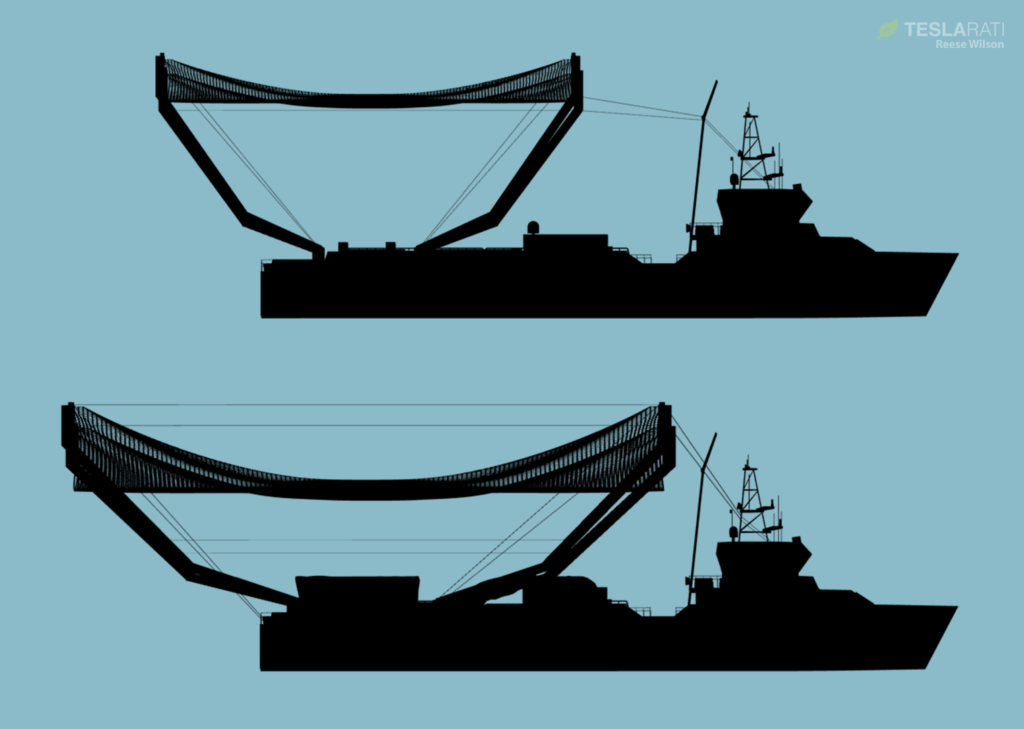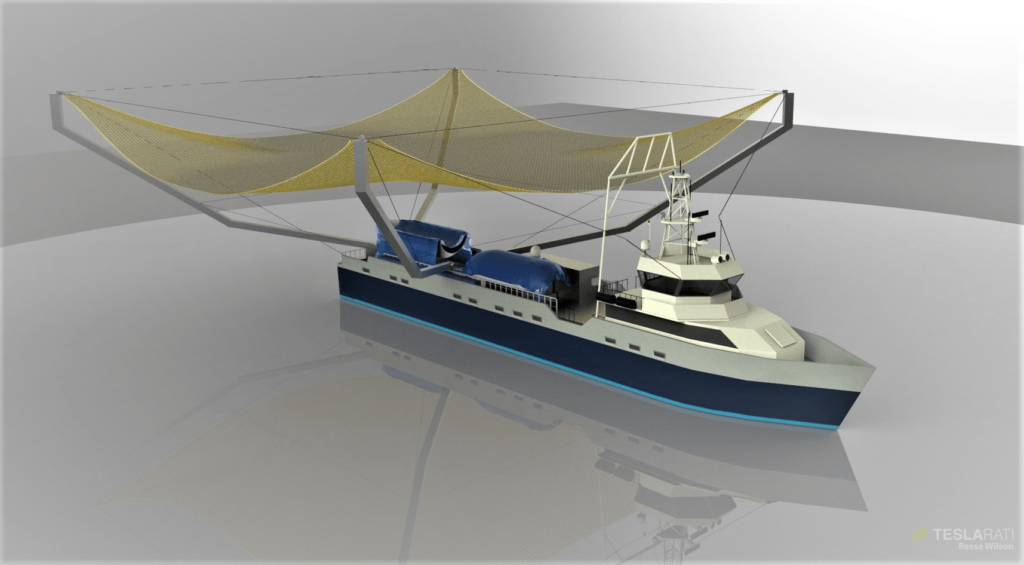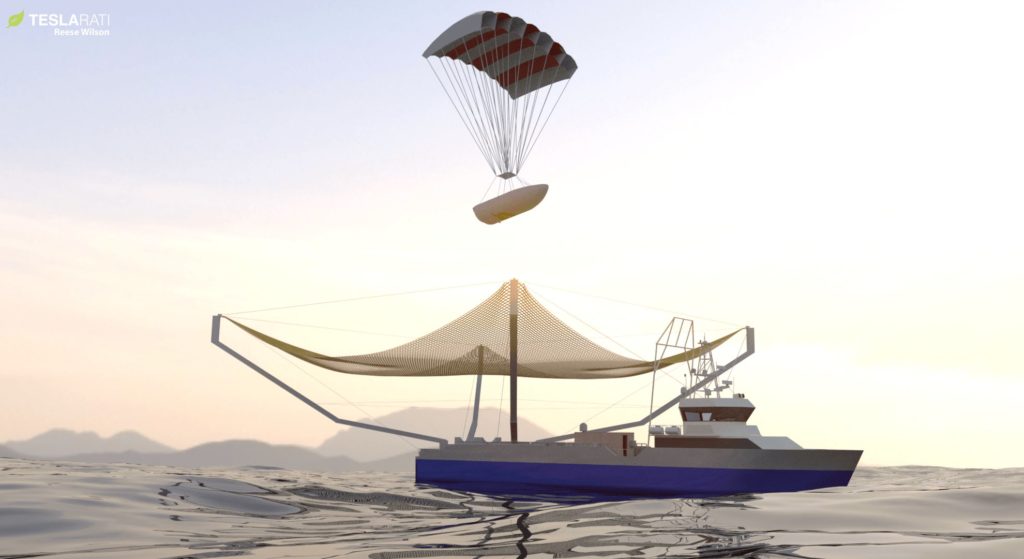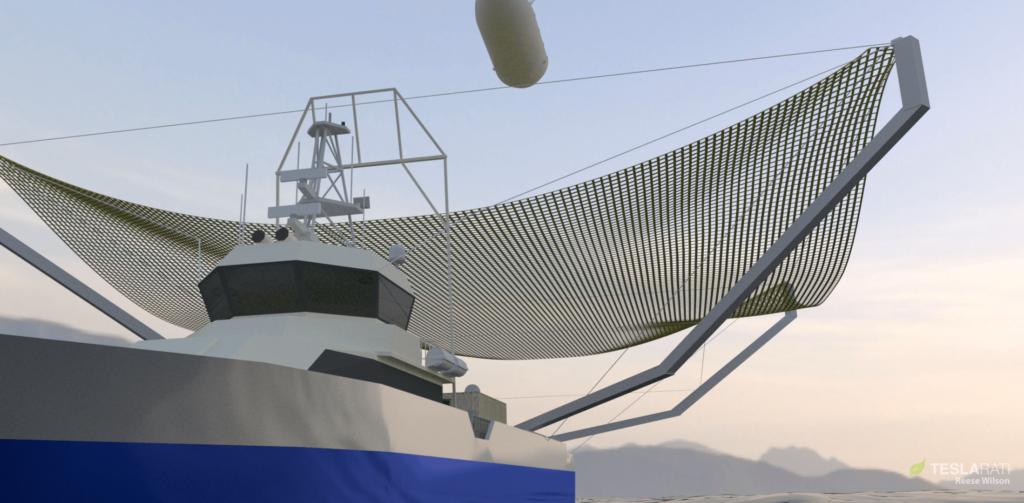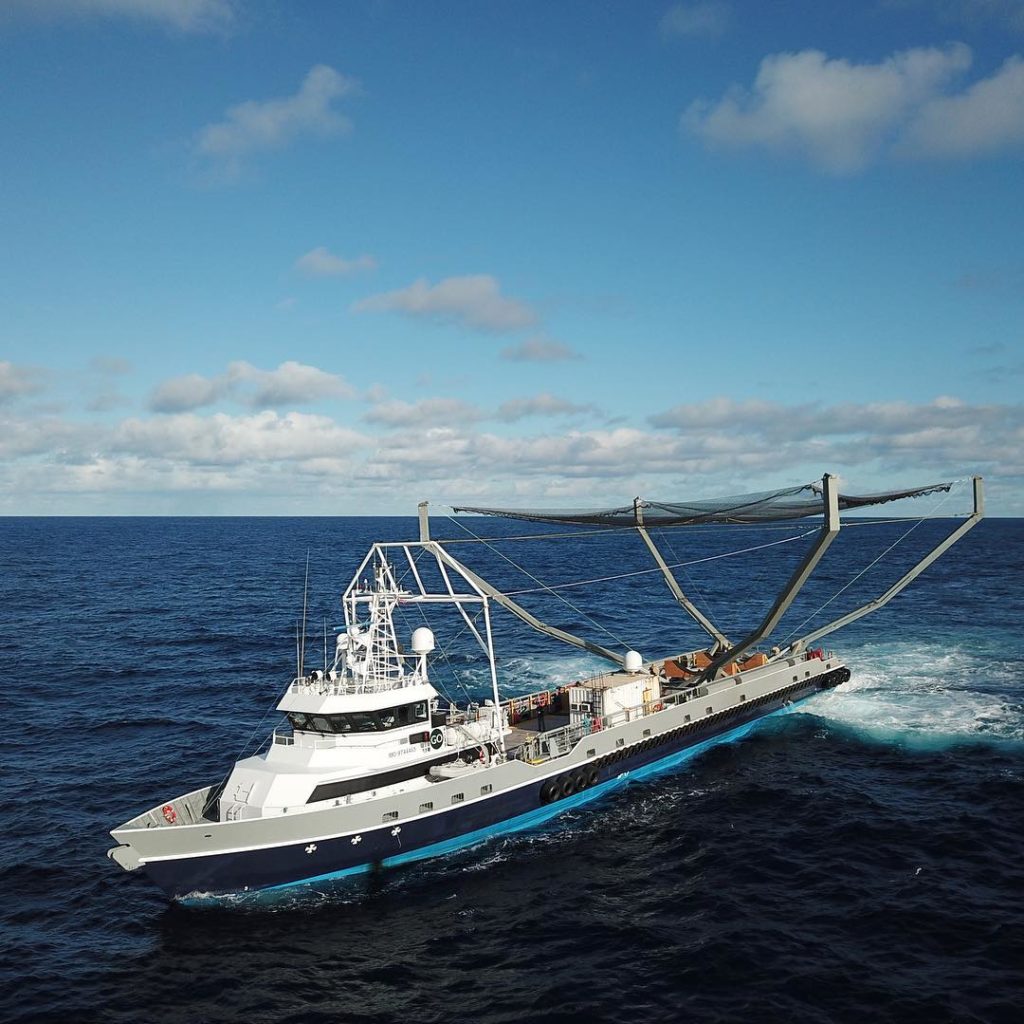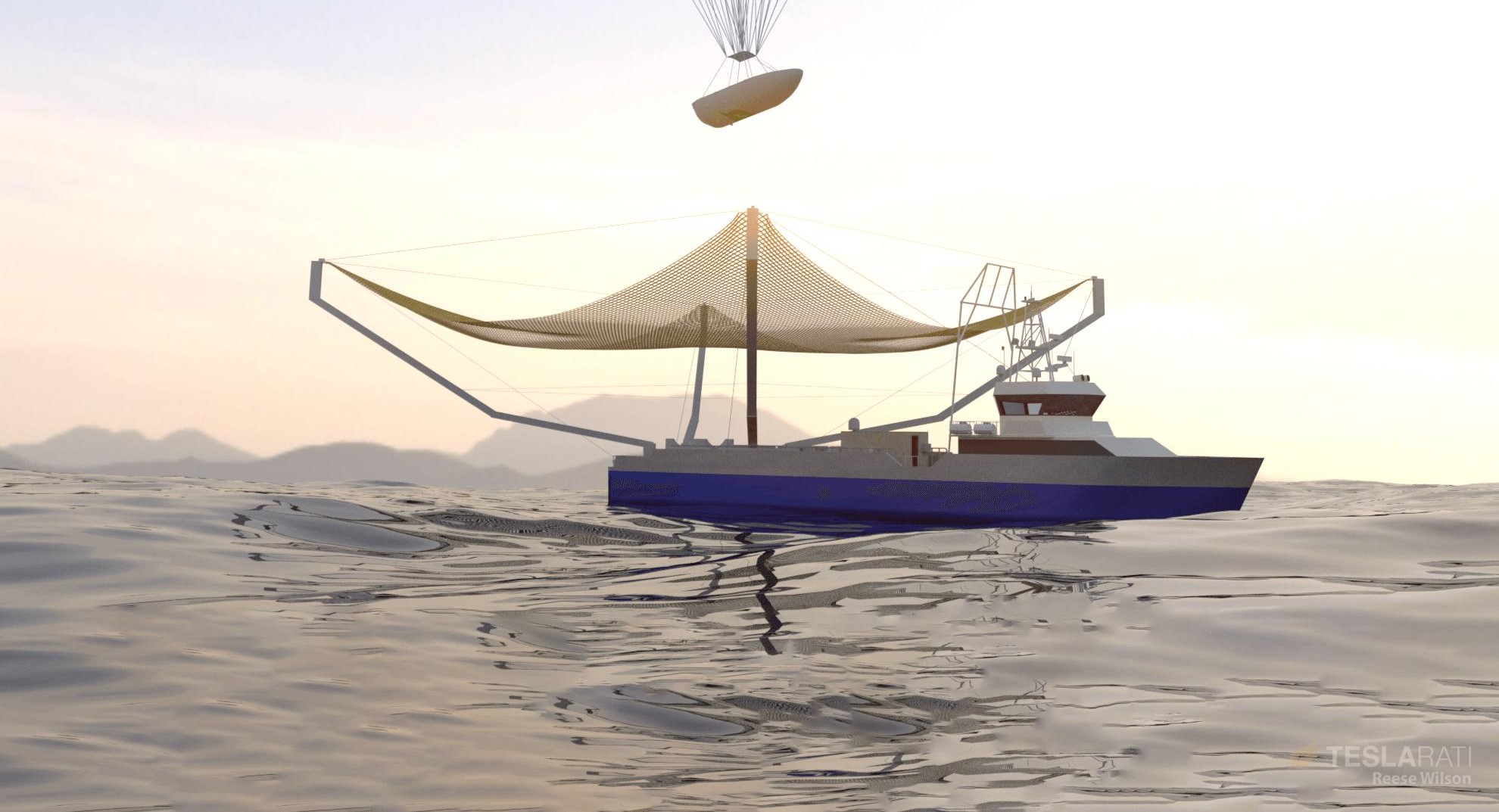
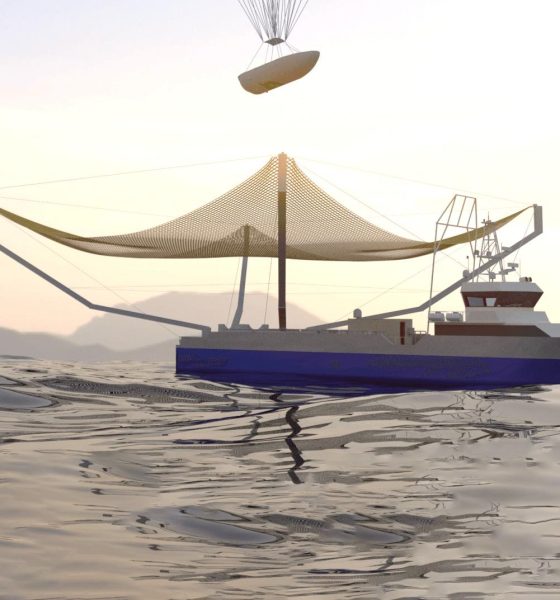
News
Renderings of SpaceX clawboat’s huge net upgrade is a taste of what’s to come
After several close-but-no-cigar attempts at snatching a Falcon 9 payload fairing out of the air, SpaceX’s iconic recovery vessel Mr Steven is currently laid up at the company’s newly-acquired Berth 240 dock space, roughly a week into the process of upgrading his arms to support a much larger net. CEO Elon Musk recently hinted that the boat’s net would be expanded by a factor of four, but what would such a dramatic growth look like?
To give a better idea of what to expect from Mr Steven’s arm and net upgrades, Teslarati’s Reese Wilson modeled and rendered the fairing recovery vessel with one such interpretation. The dimensions and aspect ratios may not be a mirror-image of the real-world Mr Steven, but the visual effect of the net upgrade is still fundamentally the same.
With respect to these renders, the actual net growth is somewhat less than the full fourfold area upgrade mentioned by Musk in early June – the concept art’s net is closer to 2.5 or 3 times larger than Mr Steven’s original net. This slight inaccuracy may actually be serendipitous, as a true 4X net could be downright unwieldy without the addition of some sort of complex retraction mechanism, versus the simple but functional (and infinitely reliable) implementation of fixed steel arms at the current net’s scale.
- A side-by-side comparison of Mr Steven before (top) and after (bottom) installation of a net with roughly 2.5X greater catching area. (Reese Wilson)
- Incredibly, this artist rendering of a much larger net installed on Mr Steven was perhaps two or more times smaller than the solution now installed on the vessel. (Reese Wilson)
Dramatic modifications nevertheless are all but guaranteed, as Mr Steven appears to have had the entire arm apparatus – including the steel base attaching them to his cargo deck – completely removed and placed on the side of the dock, still less permanent than the apparent decision to plasma or torch cut each arm off of that base, one of which is visible dockside at Berth 240. It may be possible to re-weld those severed arms onto the base, but it’s arguably more likely that entirely new arms, an entirely new base, or both will be fabricated, and those larger arms will themselves require a much larger net.
Ultimately, the fairing recovery vessel has gotten as close as 50 meters to gently catching a parasailing rocket fairing minutes after launch, an extraordinarily tiny error compared to the broader scope of the task at hand. Upon separation from Falcon 9’s upper stage, each payload fairing half is routinely traveling at speeds of 1.5 to 2 kilometers per second and reach apogees anywhere from 100 to 130 kilometers, all while traveling the better part of a thousand miles (800 mi/1300 km for Iridium-6) to reach Mr Steven’s net. As such, “missing” by 50 meters is an extraordinary achievement.
- A fairing floats gently into the welcoming embrace of Mr Steven’s upgrade net and arms. (Reese Wilson)
- With any luck, viewers may get a live view of the vessel’s next recovery attempts. (Reese Wilson)
- Mr Steven is currently undergoing arm surgery (upgrades) at SpaceX’s future BFR factory lot, known as Berth 240. (Elon Musk)
A fairing floats gently into the welcoming embrace of Mr Steven’s upgrade net and arms. (Reese Wilson)
With the vessel’s current net roughly 30 meters or 100 feet square (Mr Steven is 60m/200ft bow to stern), give or take 25%, a full fourfold upgrade would double each dimension, which could singlehandedly cut the error margin required for fairing recovery (currently 50 meters) by more than 50% if it remains square. If SpaceX finds a way to functionally achieve something close to a fourfold increase in area with a more rectangular aspect ratio (assuming that the fairing’s present error is more a matter of glideslope inaccuracy than properly pointing the half at Mr Steven), a rectangular net with a width ~50% and length ~300% larger – say 40 meters by 80 meters – would completely close the error gap between reliably missing and reliably catching Falcon fairings. To compare, a common football (soccer for our American readers) field is typically 70 meters by 100 meters.
Time will tell, and we’ll find out soon whether those arm and net upgrades can be available for SpaceX’s next California launch, currently scheduled on the morning of July 20th.

One half of SpaceX’s Iridium-6/GRACE-FO just moments before touchdown on the Pacific Ocean. (SpaceX)
Follow us for live updates, peeks behind the scenes, and photos from Teslarati’s East and West Coast photographers.
Teslarati – Instagram – Twitter
Tom Cross – Twitter
Pauline Acalin – Twitter
Eric Ralph – Twitter

News
Tesla (TSLA) receives “Buy” rating and $551 PT from Canaccord Genuity
He also maintained a “Buy” rating for TSLA stock over the company’s improving long-term outlook, which is driven by autonomy and robotics.

Canaccord Genuity analyst George Gianarikas raised his Tesla (NASDAQ:TSLA) price target from $482 to $551. He also maintained a “Buy” rating for TSLA stock over the company’s improving long-term outlook, which is driven by autonomy and robotics.
The analyst’s updated note
Gianarikas lowered his 4Q25 delivery estimates but pointed to several positive factors in the Tesla story. He noted that EV adoption in emerging markets is gaining pace, and progress in FSD and the Robotaxi rollout in 2026 represent major upside drivers. Further progress in the Optimus program next year could also add more momentum for the electric vehicle maker.
“Overall, yes, 4Q25 delivery expectations are being revised lower. However, the reset in the US EV market is laying the groundwork for a more durable and attractive long-term demand environment.
“At the same time, EV penetration in emerging markets is accelerating, reinforcing Tesla’s potential multi‑year growth runway beyond the US. Global progress in FSD and the anticipated rollout of a larger robotaxi fleet in 2026 are increasingly important components of the Tesla equity story and could provide sentiment tailwinds,” the analyst wrote.
Tesla’s busy 2026
The upcoming year would be a busy one for Tesla, considering the company’s plans and targets. The autonomous two-seat Cybercab has been confirmed to start production sometime in Q2 2026, as per Elon Musk during the 2025 Annual Shareholder Meeting.
Apart from this, Tesla is also expected to unveil the next-generation Roadster on April 1, 2026. Tesla is also expected to start high-volume production of the Tesla Semi in Nevada next year.
Apart from vehicle launches, Tesla has expressed its intentions to significantly ramp the rollout of FSD to several regions worldwide, such as Europe. Plans are also underway to launch more Robotaxi networks in several more key areas across the United States.
News
Waymo sues Santa Monica over order to halt overnight charging sessions
In its complaint, Waymo argued that its self-driving cars’ operations do not constitute a public nuisance, and compliance with the city’s order would cause the company irreparable harm.

Waymo has filed a lawsuit against the City of Santa Monica in Los Angeles County Superior Court, seeking to block an order that requires the company to cease overnight charging at two facilities.
In its complaint, Waymo argued that its self-driving cars’ operations do not constitute a public nuisance, and compliance with the city’s order would cause the company irreparable harm.
Nuisance claims
As noted in a report from the Los Angeles Times, Waymo’s two charging sites at Euclid Street and Broadway have operated for about a year, supporting the company’s growing fleet with round-the-clock activity. Unfortunately, this has also resulted in residents in the area reportedly being unable to sleep due to incessant beeping from self-driving taxis that are moving in and out of the charging stations around the clock.
Frustrated residents have protested against the Waymos by blocking the vehicles’ paths, placing cones, and “stacking” cars to create backups. This has also resulted in multiple calls to the police.
Last month, the city issued an order to Waymo and its charging partner, Voltera, to cease overnight operations at the charging locations, stating that the self-driving vehicles’ activities at night were a public nuisance. A December 15 meeting yielded no agreement on mitigations like software rerouting. Waymo proposed changes, but the city reportedly insisted that nothing would satisfy the irate residents.
“We are disappointed that the City has chosen an adversarial path over a collaborative one. The City’s position has been to insist that no actions taken or proposed by Waymo would satisfy the complaining neighbors and therefore must be deemed insufficient,” a Waymo spokesperson stated.
Waymo pushes back
In its legal complaint, Waymo stated that its “activities at the Broadway Facilities do not constitute a public nuisance.” The company also noted that it “faces imminent and irreparable harm to its operations, employees, and customers” from the city’s order. The suit also stated that the city was fully aware that the Voltera charging sites would be operating around the clock to support Waymo’s self-driving taxis.
The company highlighted over one million trips in Santa Monica since launch, with more than 50,000 rides starting or ending there in November alone. Waymo also criticized the city for adopting a contentious strategy against businesses.
“The City of Santa Monica’s recent actions are inconsistent with its stated goal of attracting investment. At a time when the City faces a serious fiscal crisis, officials are choosing to obstruct properly permitted investment rather than fostering a ‘ready for business’ environment,” Waymo stated.
News
Tesla FSD v14.2.2 is getting rave reviews from drivers
So far, early testers have reported buttery-smooth drives with confident performance, even at night or on twisty roads.

Tesla Full Self-Driving (Supervised) v14.2.2 is receiving positive reviews from owners, with several drivers praising the build’s lack of hesitation during lane changes and its smoother decision-making, among others.
The update, which started rolling out on Monday, also adds features like dynamic arrival pin adjustment. So far, early testers have reported buttery-smooth drives with confident performance, even at night or on twisty roads.
Owners highlight major improvements
Longtime Tesla owner and FSD user @BLKMDL3 shared a detailed 10-hour impression of FSD v14.2.2, noting that the system exhibited “zero lane change hesitation” and “extremely refined” lane choices. He praised Mad Max mode’s performance, stellar parking in locations including ticket dispensers, and impressive canyon runs even in dark conditions.
Fellow FSD user Dan Burkland reported an hour of FSD v14.2.2’s nighttime driving with “zero hesitations” and “buttery smooth” confidence reminiscent of Robotaxi rides in areas such as Austin, Texas. Veteran FSD user Whole Mars Catalog also demonstrated voice navigation via Grok, while Tesla owner Devin Olsen completed a nearly two-hour drive with FSD v14.2.2 in heavy traffic and rain with strong performance.
Closer to unsupervised
FSD has been receiving rave reviews, even from Tesla’s competitors. Xpeng CEO He Xiaopeng, for one, offered fresh praise for FSD v14.2 after visiting Silicon Valley. Following extended test drives of Tesla vehicles running the latest FSD software, He stated that the system has made major strides, reinforcing his view that Tesla’s approach to autonomy is indeed the proper path towards autonomy.
According to He, Tesla’s FSD has evolved from a smooth Level 2 advanced driver assistance system into what he described as a “near-Level 4” experience in terms of capabilities. While acknowledging that areas of improvement are still present, the Xpeng CEO stated that FSD’s current iteration significantly surpasses last year’s capabilities. He also reiterated his belief that Tesla’s strategy of using the same autonomous software and hardware architecture across private vehicles and robotaxis is the right long-term approach, as it would allow users to bypass intermediate autonomy stages and move closer to Level 4 functionality.

